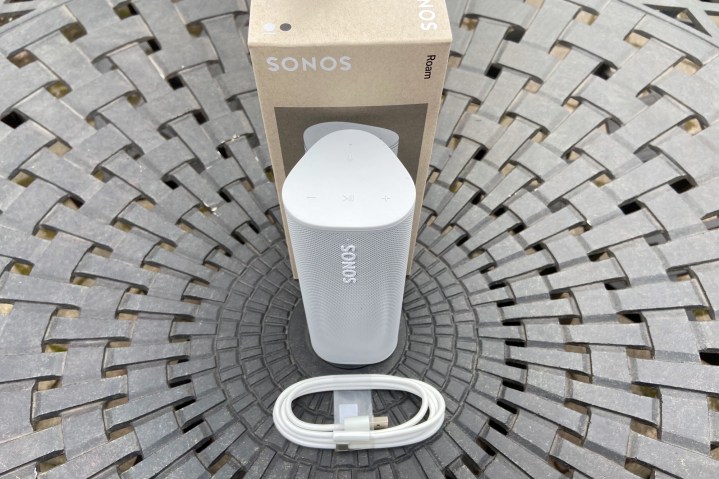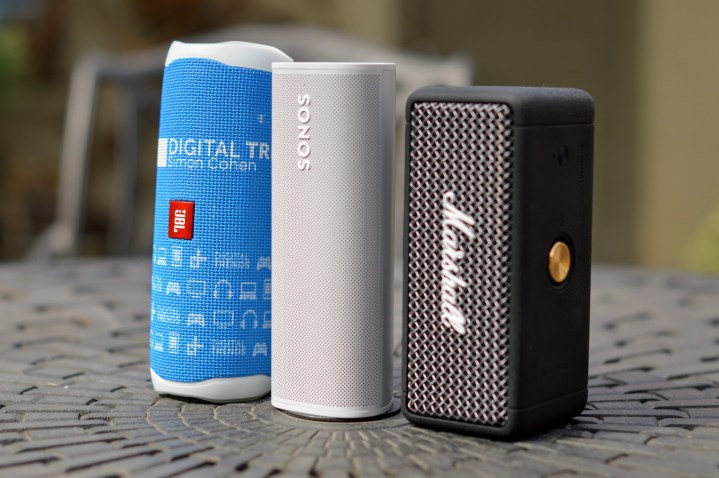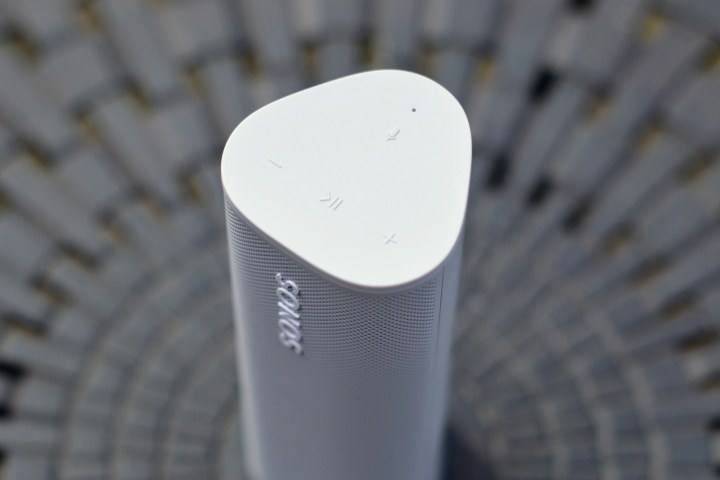
- Excellent design
- Lightweight and portable
- Totally water and dustproof
- Very good sound for its size
- Choice of smart speaker assistants
- Wireless charging
- No Bluetooth stereo pairing
- Doesn’t work as a speakerphone
- Less battery life than some other speakers
The $399 Sonos Move is a very capable wireless speaker. When at home, it can connect to the rest of your Sonos gear, and its built-in microphone lets it act as a Google- or Alexa-powered smart speaker. On the road, its Bluetooth radio and 10-hour rechargeable battery makes for a powerful, portable sound system. Well, maybe not that portable.
In truth, as good as the Move is, it’s never going to be a grab-and-go speaker because it’s simply too big and too heavy. Going from the living room to the patio? Grab the Move. Going from the patio to the park? That’s a different story.
But now we have the $169 Sonos Roam. It’s got all of the Move’s capabilities (and then some), but it’s a fraction of the Move’s size, weight, and price. Does this make the Roam a no-brainer purchase for Sonos fans? Let’s check it out.
What’s in the box?

Sonos has long been a leader in sustainably packaged products, but the Roam is its best effort yet. It even includes a handy label to help determine which parts can be recycled.
Inside the small, plainly printed cardboard box, you’ll find the Roam, a USB-C charging cable, a printed quick-start guide, and not a hint of plastic or foam.
Design

The first thing that strikes you when you unbox the Sonos Roam is just how small it is. It’s not just the smallest Sonos speaker by a huge margin, at a hair over 6.5 inches tall, but it’s also a bit smaller and lighter than many of the Bluetooth speakers it will be competing with, like the $120 JBL Flip 5 and the $150 Marshall Emberton.
The Roam’s shape practically begs you to scoop it up and take it with you.
Despite its diminutive size, the Roam’s minimalist design is pure Sonos, whether clad in matte black or matte white like our review unit.
Its Toblerone-esque triangular shape isn’t just for looks; it makes the Roam supremely grabbable. Angle any of its three sides toward your palm, and your fingers naturally curl around the curved edges, along the other two sides. Where the Move’s integrated carry handle always feels a little risky when you grab it, the Roam’s shape practically begs you to scoop it up and take it with you.
The only thing missing is an integrated lanyard option for times when you need your hands free.
You can stand the Roam up vertically or lay it down horizontally using the four built-in rubber feet to keep it securely anchored to whatever surface you choose.
Either way, the Roam’s simple elegance lets it blend invisibly with almost any decor.

The physical controls are also very stealthy — a set of four buttons that are hidden behind a layer of rubber on the top panel, barely hinted at by their slightly raised icons. From a distance of a few feet, they disappear completely.
The speaker grille, with its thousands of tiny perforations, smoothly integrates into the Roam’s body. It looks like it could end up getting badly dented, but behind that thin layer is a much more robust hexagonal lattice, which gives the grille an impressive amount of rigidity.
Two tiny LED lights hidden behind the grille tell you the speaker’s status: One light that shows whether you’re in Wi-Fi or Bluetooth mode and one that indicates the battery’s charge level. A third light next to the microphone button lets you know when the mic is active — Sonos says this is hard-wired to the mic circuitry so when the light is off, you can be assured that no one is listening.

Around the back, you’ll find the USB-C charging port and a tiny power button that is also used for Bluetooth pairing. When you’re home, you’ll want to leave the Roam continuously plugged in to power so it’s always ready to play your tunes, but if you’re likely to move it about a lot, you’ll want to take advantage of its wireless charging feature.
Sonos sells a $50 custom Qi charger that is shaped to match the bottom of the Roam and can stay magnetically latched until you need it, but I didn’t get one to test. Not that it matters — any Qi charging mat will do the job, and I found it very easy to just leave the Roam sitting on one when I wasn’t carting it around.
Setup and configuration
If you’re a Sonos owner, you don’t need me to tell you how easy it is to set up the company’s wireless speakers. A few taps in the Sonos app, a few button presses on the speaker, and less than two minutes later, you’re done. But with the Roam, Sonos has simplified this process even further.
Every tech product should be this easy to configure.
After connecting the Roam to a power source using the included USB-C cable (or a wireless charger) and opening the Sonos S2 app, you are automatically prompted by the app to set up the speaker. It’s a lot like the way Apple’s AirPods will prompt you when you open their charging case for the first time.
The next step is to tap the back of your phone against the back of the Roam. This should trigger the speaker’s NFC sensor to recognize your phone so it can complete the process.
Unfortunately, this didn’t work with my iPhone 11, but after two failed attempts, the Sonos app provided a different solution: It caused the Roam to emit an audible chime, which was picked up by the iPhone’s mic, and the setup automatically completed, including the addition of the Roam to my Wi-Fi network. No buttons to press and no passwords to enter. Every tech product should be this easy to configure.
At this point, you’ll be able to play music from the Sonos app, manage the Roam as a single speaker or as part of a group of Sonos products, or stream audio directly to the Roam using Apple AirPlay.
But given that the Roam can also act as a smart speaker, you may want to take the extra step of adding it to the Google Home app or the Amazon Alexa app — something that takes only a few extra minutes.
Sound quality

In keeping with Sonos’ reputation for products that punch well above their weight class, the Roam sounds awesome for such a small speaker.
It delivers a warm yet clear signature, with a decent amount of resonance considering just how compact it is.
Indoors, the Roam is an ideal speaker for smaller rooms.
When you’re on Wi-Fi, the Sonos app lets you adjust bass and treble if you want to override the factory EQ — a tweak that will be maintained even if you switch to Bluetooth operation.
Indoors, the Roam is an ideal speaker for smaller rooms — like a bedroom, a bathroom, or even a kitchen. Outdoors, it gets loud enough to power a pool party or backyard get-together. Speaking of volume, the Roam is effectively distortion-free all the way up to its loudest setting, and there’s no unpleasant buzzing of the speaker cabinet, something that can happen with lesser-quality Bluetooth speakers.
As you climb up the volume settings, the Roam manages to keep the frequencies balanced — until you hit about 75%. Once you exceed this limit, the speaker simply has no more low- or midrange left and leverages the high frequencies to get to its maximum volume.
There’s simply no way a speaker of this size can deliver the kind of deep bass or powerful sound of larger devices, but if you place the Roam in a corner — a proven method for enhancing bass-response — it’s surprising just how deep the sound can get.
The Roam outshines the JBL Flip 5 for clarity and tonal quality, but it delivers an almost identical signature to the Marshall Emberton.
The Emberton proved slightly more flexible for outdoor gatherings thanks to its 360-degree speaker pattern, whereas the Roam is more directional.
In theory, the Roam’s Automatic Trueplay feature will continually adapt the Roam’s sound based on where you place it. It works whether you’re using Bluetooth or Wi-Fi, and you won’t find it on any other wireless speaker that doesn’t bear the Sonos brand.
In practice, I found it difficult to determine whether Auto Trueplay was actually making a significant difference. I moved the Roam into various places both inside and outdoors, turning Auto Trueplay on and off to see if I could tell. For the most part, the changes were barely detectable, even when I placed the speaker in locations that should have prompted a big adjustment (like the corner placement mentioned above).
Usability

If you’ve never used the Sonos app and the Roam is your first Sonos product, you’re in for a treat. It is, bar none, the best audio streaming software on the planet. Not only is it compatible with just about every streaming music source imaginable — over 100 so far — but all that music is incredibly easy to navigate and find thanks to the universal search feature.
The Sonos software is so good, it’s reason enough to buy the Roam over any other portable speaker in its price range.
You can create your playlists and favorites that work independently from the ones you may have already created on your music apps, and once you have more than one Sonos speaker, you can control each speaker independently or as a group.
Most other Wi-Fi speakers rely on Apple HomeKit, Google Home, or Amazon Alexa for their multiroom functionality, but these cannot hold a candle to the Sonos app’s extensive feature set.
The Sonos software is so good, it’s reason enough to buy the Roam over any other portable speaker in its price range.
Like every other Sonos speaker, the controls are as intuitive as it gets. The two volume buttons work exactly as you’d expect, while the Play/Pause button can skip one track forward with a double press or backward with a triple press.
Switching from Wi-Fi to Bluetooth is also dead simple. A long press on the small button on the back panel shifts the speaker to Bluetooth mode, and the Roam will automatically re-pair with the last paired device.
Pairing a second or third device is a bit more complicated. You need to disable the Bluetooth radio on the currently paired device so that the Roam knows to initiate Bluetooth pairing again. But once the second (or third, etc.) device has been paired, you can control which one the Roam is talking to without repeating the pairing process.
Unfortunately, Sonos doesn’t support stereo pairing of its speakers over Bluetooth. To do this, you need to be on your home Wi-Fi network, and you need to have a matched set of Sonos speakers — the Roam can only stereo pair with a second Roam, and even a paired set of Roams can’t be used as surround speakers for a Sonos Arc, Beam, Playbase, or Playbar.
And despite the presence of a microphone, you can’t use the Roam as a speakerphone — which is a bit of a bummer given how many businesspeople are likely to pack the Roam in their bags when they travel.
Smart speaker skills

The Sonos Roam is by far the most affordable portable speaker that can also double as a smart speaker — and it’s one of the few that gives you a choice between Amazon Alexa and Google Assistant.
It’s astonishing how easily the Roam can hear and respond to your commands
I set it up with Google Assistant, a process that takes about two minutes and requires you to have the Google Assistant app installed on your phone.
Once you’re good to go, it’s astonishing how easily the Roam can hear and respond to your commands. For fun, I placed the Roam at one end of our yard and called out “Hey Google,” from the other end — a distance of about 40 feet. The Roam heard and responded right away.
Smart speakers are pretty darned handy, letting you do everything from managing music playback to organizing your shopping lists and controlling smart home devices like lights and cameras. But smart speakers usually need to stay tethered to power, which is why folks will often buy a Nest Mini or Echo Dot for each room in their house. Because the Roam is fully wireless, it can go wherever you go and will continue to work as a smart speaker as long as it has access to Wi-Fi.
The Ultimate Ears Blast and JBL Link Portable can do this too, but they cost $10 more than the Roam, and they only work with one assistant (Amazon Alexa for the Blast, Google Assistant for the Link Portable).
If freedom of choice is important to you, the Sonos Roam is clearly the best option.
Extras

What makes the Sonos Roam such a remarkable speaker is its extra features. Some, like wireless charging, Auto Trueplay, AirPlay, and its ability to double as an assistant-agnostic smart speaker, are tangible benefits for anyone who buys it.
But if you have or are planning to buy other Sonos products, there are even more cool features on tap, like Sound Swap, which lets you transfer a Wi-Fi streaming session to and from the Roam by pressing and holding the Play/Pause button. It only works with newer Sonos products like Sonos One, One SL, Beam, Move, and Arc, but it works flawlessly.
You can also leverage the Roam’s Bluetooth connection as a source for your other Sonos speakers. For instance, if you’re away from home using the Roam as a Bluetooth speaker, then when you return home, you can open the Sonos app and group your other speakers with the Roam, which will then share the Roam’s BT session with the group.
This is also a great solution for giving guests access to your Sonos system without giving them your Wi-Fi password or forcing them to download and install the Sonos app.
It’s also a great solution for streaming songs that are locally stored on your phone — a feature Sonos used to offer from within its app.
Battery life
At a claimed 10 hours of battery life, the Roam won’t set any stamina records, especially when you consider that the JBL Flip 5 gets 12 hours and the Marshall Emberton packs 20 hours. On the other hand, the Emberton weighs 40% more than the Roam.
Still, 10 hours is probably more than enough for a day trip, and if you need to extend the Roam’s play time, you can always bring along a portable battery pack since the Roam (unlike the Move) can charge from virtually any USB power source.
Ruggedness

With an IP67 rating, the Roam will be able to handle just about anything you throw at it, from full immersion in water to a sandy day at the beach. That makes it a great pool party companion as long as you’re prepared to dive in after it if it goes kerplunk: The Roam doesn’t float.
But I’m not convinced that the Roam will be able to withstand drops onto hard surfaces as well as the JBL Flip 5 or Marshall Emberton.
Despite its thin rubber end caps, the body of the Roam is unprotected hard plastic, which looks like it could crack or chip with a direct impact — some care should be taken to avoid this from happening.
Our take
Sonos has packed so many features into the Roam, it’s easily the best value in a portable speaker.
Is there a better alternative?
You can find portable speakers that have better sound quality, longer battery life, or louder volume levels, but you won’t find one that has all the features of the Sonos Roam at any price — including its more expensive big brother, the Sonos Move.
That said, if you’re willing to give up Wi-Fi, Apple AirPlay, voice commands, and the Sonos ecosystem, the $150 Marshall Emberton sounds just as good and has a 20-hour battery.
If you’re willing to give up a choice of voice assistant, Apple AirPlay, and the Sonos Ecosystem, the $180 UE Blast has longer battery life and 360-degree sound.
How long will it last?
Sonos products are very well built. When you consider its IP67 protection from dust and water, it should last many years as long as you protect it from serious impacts. All Sonos products come with a one-year warranty.
Should you buy it?
Yes, I highly recommend the Sonos Roam whether you intend on starting a new Sonos system, adding it to an existing system, or using it all on its own.
Editors' Recommendations
- Sonos app gets a major overhaul as the company prepares for next-gen products
- We’ve tried them all — these are the best Sonos speakers in 2024
- Best Bluetooth speaker deals: Save on Bose, Sonos, JBL, and more
- The best speaker brands of 2024: JBL, Sonos, KEF, and more
- The best speakers for 2024: great hi-fi options for music and more









